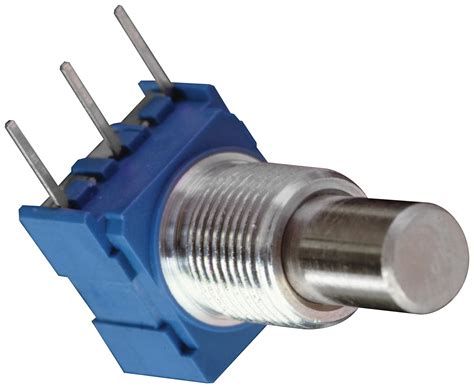Potentiometers: A Comprehensive Guide to Understanding and Using Them
Introduction
Potentiometers, commonly known as pots, are versatile electronic components that serve as variable resistors, allowing for precise control over the flow of current. Their ability to adjust resistance makes them essential in a wide range of applications, including audio volume control, sensor feedback, motor speed regulation, and more.
Types of Potentiometers
There are various types of potentiometers, each with unique characteristics and applications:
Linear Potentiometers:
- Exhibit a linear relationship between the resistance and the position of the wiper.
- Used in sensor applications, guitar volume controls, and linear motion measurements.

Rotary Potentiometers:
- Have a circular resistive track and a rotating shaft.
- Commonly employed in audio equipment, industrial controls, and temperature sensors.
Trim Potentiometers:
- Small, adjustable potentiometers designed for fine-tuning or calibration.
- Used in electronic circuits to make precise adjustments without the need for external tools.
Digital Potentiometers:
- Electronically controlled potentiometers that offer programmable resistance values.
- Provide precise digital control and are suitable for applications requiring remote adjustment or microprocessor integration.

Key Features and Specifications
Resistance Range: Potentiometers are available in a wide range of resistance values, typically from ohms to megaohms.

Taper: The taper refers to the relationship between the resistance and the wiper position. Linear taper provides a uniform change in resistance, while logarithmic taper varies exponentially.
Power Rating: The power rating indicates the maximum amount of power a potentiometer can dissipate without overheating or failing.
Tolerance: The tolerance specifies the allowable deviation from the specified resistance value.
Applications of Potentiometers
Potentiometers find extensive use in various electronic circuits and applications, including:
Audio Equipment: Volume control, tone adjustment, and equalization.
Industrial Controls: Motor speed regulation, temperature monitoring, and signal conditioning.
Sensor Feedback: Providing feedback signals for sensors measuring temperature, pressure, or position.
Medical Devices: Adjusting the intensity of medical equipment such as lasers and electrosurgical units.
Automotive Industry: Controlling lighting, climate control, and entertainment systems.
Market Statistics and Trends
According to market research firm Mordor Intelligence, the global potentiometer market size was valued at USD 1.35 billion in 2021 and is projected to grow to USD 2.01 billion by 2027. The increasing adoption of electronic devices, automation in industries, and demand for precise control systems drive this growth.
Benefits of Using Potentiometers
Versatility: Potentiometers can be used in a wide variety of applications, making them a highly adaptable component.
Precise Control: They provide precise control over the flow of current, enabling accurate adjustments and fine-tuning.
Durability: Potentiometers are generally reliable and durable components, with a long lifespan when used within their specifications.

Challenges and Limitations
Wear and Tear: Continuous use of potentiometers can cause wear and tear on the wiper contact, affecting the accuracy and reliability of the component.
Environmental Factors: Harsh environmental conditions, such as extreme temperatures or humidity, can impact the performance and lifespan of potentiometers.
Effective Strategies for Using Potentiometers
Proper Sizing: Select potentiometers with the appropriate resistance range, power rating, and size for the specific application.
Mounting Considerations: Ensure proper mounting to prevent vibrations or mechanical stresses that could damage the potentiometer.
Maintenance: Regular cleaning and inspection can help extend the lifespan and maintain the accuracy of potentiometers.
Stories and Lessons Learned
Scenario 1: In a manufacturing facility, a trim potentiometer used to calibrate a sensor malfunctioned due to improper mounting. The misalignment caused excessive wear on the wiper contact, leading to inaccurate sensor readings and production errors.
Lesson: Proper mounting and handling of potentiometers are crucial for reliable performance.
Scenario 2: A guitarist experienced erratic volume control on their electric guitar, which was traced to a worn-out rotary potentiometer in the volume knob. Replacing the potentiometer restored consistent and precise volume adjustment.
Lesson: Regular maintenance and replacement of worn-out potentiometers can prevent potential performance issues.
Scenario 3: A medical device manufacturer encountered challenges with controlling the intensity of a laser beam due to fluctuations in the power supply. Implementing a digital potentiometer with programmable resistance values enabled precise adjustment and maintained consistent laser intensity.
Lesson: Digital potentiometers can offer programmable control and enhance performance in applications requiring precise adjustments.
FAQs
1. What is the difference between a linear and a rotary potentiometer?
A linear potentiometer has a linear relationship between resistance and wiper position, while a rotary potentiometer has a circular resistive track and a rotating shaft.
2. How do I choose the right size potentiometer for my application?
Consider the resistance range, power rating, and physical size requirements for the intended use.
3. What factors affect the accuracy of a potentiometer?
Factors include tolerance, wear and tear, environmental conditions, and proper mounting.
4. Can potentiometers be used in digital circuits?
Yes, digital potentiometers offer programmable resistance values and can be integrated into digital circuits.
5. How can I extend the lifespan of a potentiometer?
Regular cleaning, proper mounting, and avoiding overloads can help extend the lifespan of potentiometers.
6. What are some common applications of potentiometers?
Potentiometers are used in audio equipment, industrial controls, sensor feedback, medical devices, and automotive systems.
Call to Action
Potentiometers are essential components in a variety of electronic applications, offering precise control over the flow of current. Understanding their types, specifications, and applications is crucial for effective implementation and troubleshooting. By utilizing the information and strategies provided in this comprehensive guide, engineers and technicians can leverage the benefits of potentiometers to optimize performance and ensure reliable operation in their designs.
